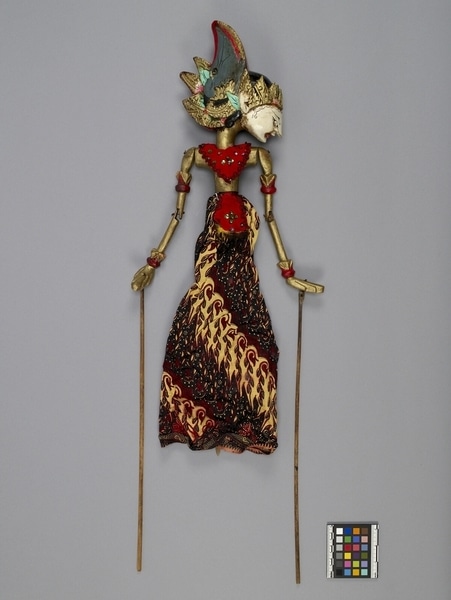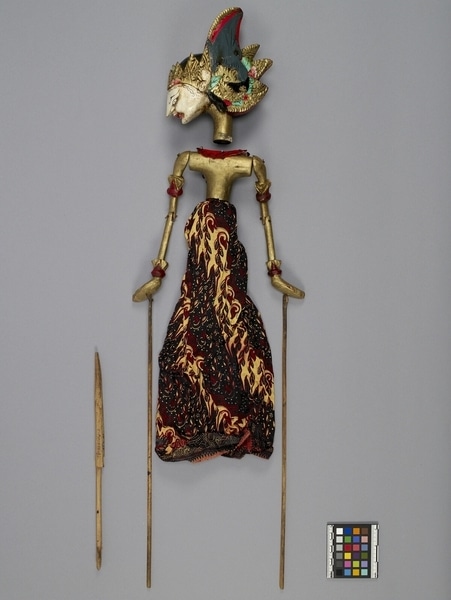Rod Puppet Item Number: Ib411 a-c from the MOA: University of British Columbia


Description
Three-dimensional male humanoid puppet: large head (part b) fits into body with skirt (part a), and a control rod (part c) with a long shaft that passes through the body and fits into the neck of the figure's head. The body has jointed arms, each with a long controlling rod attached. Head positioned downwards; white face with straight, pointed nose, small red mouth and small teeth. Eyes, moustache, hair, and other facial details in black. Brown staining on head and headdress. Large grey Garuda Mungkur facing the rear on headdress; diadem, sumping, badong, and siyung jawi. Conventional sekar kluwih headdress, in red, gold, and green. Neck and upper torso gold; red and gold ornaments on each arm at bicep and wrist. Hands held flat and bent back at wrist. Red chest covering and apron with blue and green sequins with bead centres, and brown outline sewn on. Apron has stained yellow fringe. Batik skirt (blue, purple on beige).
History Of Use
Javanese puppetry as an art form probably developed by the 11th century. Wayang golek puppets of western Java appeared during the 16th century. Originally the plays depicted Javanese mythology, but after the Indian conquest of Java the Hindu epics, Ramayana and Mahabharata, were incorporated into the cycles, which comprise about 200 plays. A dalang (puppet master) performs the plays to celebrate important occasions, usually in three acts, with vocal and instrumental accompaniment. Typically they serve a moral and religious purpose, and more recently, one of political commentary. Important characters often have more than one puppet to represent differences in state or mood. They usually have other names. In this case, the puppet seems to be varied only slightly from one of two puppets, Parikesit (the more likely because of the white face) or Salya. Both characters are found in the Mahabharata cycle, both are princes (raden) early in the cycle, Parikesit later becomes a king (prabu).
Iconographic Meaning
Each puppet is characterized by its wanda, a Javanese word which describes the specific mixture of elements of size, form, colour, ornamentation and carving. Colour and position of face suggests virtue; headdress, batik, arm ornaments, and position of hands, and particularly gold skin indicates high nobility. Character possibly a slight variation of Salya or Parikesit. Differs in hair (only kendit), and white face. Headdress matches.
Cultural Context
Theatrical performance.
Item History
- Made in Java, Indonesia
- Owned by Donald Bone before January 4, 1980
- Received from Donald Bone (Seller) and Museum of Anthropology Donations Fund (Funding source) on January 4, 1980
What
- Name
- Rod Puppet
- Identification Number
- Ib411 a-c
- Type of Item
- puppet
- Material
- wood, cotton fibre, fibre and paint
- Manufacturing Technique
- carved, painted, tied, woven and sewn
- Part A
- height 68.0 cm, width 17.5 cm, depth 6.5 cm
- Part B
- height 22.0 cm, width 9.5 cm, depth 17.5 cm
- Part C
- height 34.0 cm, diameter 1.5 cm
Who
- Culture
- Sundanese
- Previous Owner
- Donald Bone
- Received from
- Donald Bone (Seller) and Museum of Anthropology Donations Fund (Funding source)
Where
- Holding Institution
- MOA: University of British Columbia
- Made in
- Java, Indonesia
When
- Ownership Date
- before January 4, 1980
- Acquisition Date
- on January 4, 1980
Other
- Condition
- fair
- Accession Number
- 0586/0031 a-c